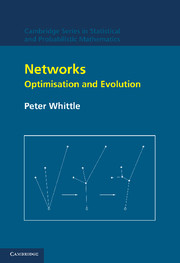Book contents
- Frontmatter
- Contents
- Acknowledgements
- Conventions on notation
- Tour d'Horizon
- Part I Distributional networks
- Part II Artificial neural networks
- Part III Processing networks
- Part IV Communication networks
- 15 Loss networks: optimisation and robustness
- 16 Loss networks: stochastics and self-regulation
- 17 Operation of the Internet
- 18 Evolving networks and the Worldwide Web
- Appendix 1 Spatial integrals for the telephone problem
- Appendix 2 Bandit and tax processes
- Appendix 3 Random graphs and polymer models
- References
- Index
15 - Loss networks: optimisation and robustness
Published online by Cambridge University Press: 23 November 2009
- Frontmatter
- Contents
- Acknowledgements
- Conventions on notation
- Tour d'Horizon
- Part I Distributional networks
- Part II Artificial neural networks
- Part III Processing networks
- Part IV Communication networks
- 15 Loss networks: optimisation and robustness
- 16 Loss networks: stochastics and self-regulation
- 17 Operation of the Internet
- 18 Evolving networks and the Worldwide Web
- Appendix 1 Spatial integrals for the telephone problem
- Appendix 2 Bandit and tax processes
- Appendix 3 Random graphs and polymer models
- References
- Index
Summary
A telephone network consists of a network of exchanges (or routers, in more modern formulations). Many of these are themselves the centre of a local star network, in that they have direct connections to individual subscribers in the region. However, it is the exchanges that we shall regard as constituting the nodes of a network. The defining feature of a loss network is that a call is accepted only if a clear route to its destination is available, otherwise the call is lost.
Random variation can enter the system in various ways. Even if all the parameters of operation and loading are constant and equilibrium has been reached, there will be statistical variation of the numbers and types of calls in progress. This is the source that receives most attention in at least that part of the literature favoured by mathematicians. One might consider it secondary in comparison with the more radical type of uncertainty which faces the system when there are massive variations in load or major internal failures. It is these that determine system structure, by setting a premium on versatility and robustness.
Nevertheless, there will always be times when a system is working close to capacity, and real-time decisions on acceptance and routing must be made to accommodate normal statistical variation. Such circumstances are associated with the decentralised realisation of policies, and will be considered in the next chapter.
We shall then begin by considering a system operating deterministically with a fixed demand pattern. The variables (e.g. numbers of calls in progress, capacity assigned to a given link) will be regarded as continuous in this treatment.
- Type
- Chapter
- Information
- NetworksOptimisation and Evolution, pp. 193 - 198Publisher: Cambridge University PressPrint publication year: 2007

